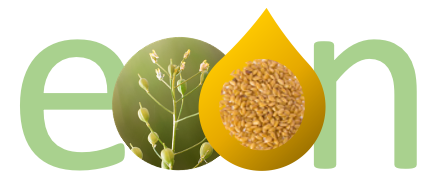
ECON: Enhancing Camelina Oilseed Production with Minimal Nitrogen Fertilization in Sustainable Cropping Systems
Camelina (Camelina sativa) is a promising non-food oilseed crop that provides a biofuel feedstock especially in the Northwest of the United States. Integration of camelina could also improve the region’s cereal-based cropping systems and boost rural economies. This interdisciplinary systems biology project addresses two critical challenges in camelina biology that hinder its great potential:
- Enhancing nitrogen utilization efficiency for economic profitability and reducing the negative environmental impact associated with nitrogen fertilization; and
- Boosting oil yield for its productivity competitiveness with other major oilseed crops such as canola.
This project addresses components of the Sustainability Research for Bioenergy at the U.S. Department of Energy.
Overview of research
This research is based on the general hypothesis, supported by previous studies in camelina and related species, that natural genetic diversity exists in camelina for its ability to absorb, translocate and assimilate nitrogen, and for its capability of recruiting beneficial rhizo-microbes to improve nitrogen acquisition from the soil. Further, it is hypothesized that the genetic diversity can be explained by variations in genome structure (polymorphic alleles) and gene expression (transcriptomes and epigenomes); and that enhanced nitrogen utilization efficiency promotes seed growth and oil biosynthesis resulting in increased seed size and oil yield.
Approaches
Modern genomics and biochemical approaches will be applied to decipher the genetic and physiological mechanisms that determine the nitrogen use efficiency and oilseed yield during the most critical processes of the camelina life cycle: 1) how camelina, in partnership with soil microbes, maximizes its ability to absorb and assimilate nitrogen into vegetative biomass; and 2) upon the transition to reproductive growth, how nitrogen is efficiently remobilized from senescing tissues into sinks to optimize yield potential by increasing seed size and enhancing oil synthesis.
Impact
This highly integrative project will provide a systems-level understanding of fundamental mechanisms in camelina that regulate nitrogen uptake, assimilation, remobilization, and seed development and oil accumulation. This knowledge is necessary for the development of next-generation high-oil-yielding camelina varieties with minimum nitrogen fertilization for sustainable bioenergy production. Besides the direct outcome of several natural and engineered camelina lines with advanced traits like large seed and high oil content, results from this research will fill knowledge gaps in many key areas of plant development, physiology and plant-microbe interactions. The basic science advancement will benefit the development of other related brassica oilseed species for sustainable production. In addition, this project will provide training opportunities for young scientists including graduate students and postdocs in genomics, biochemistry and biotechnology.
